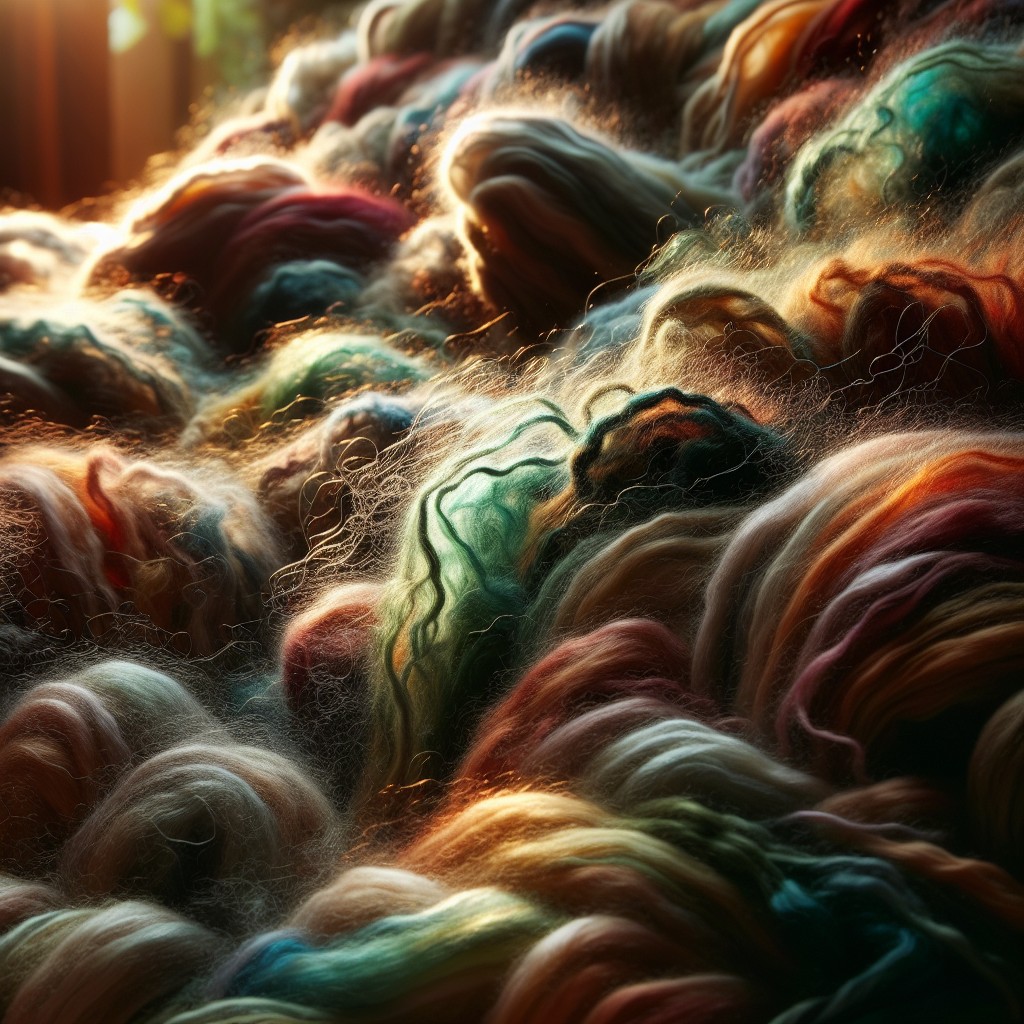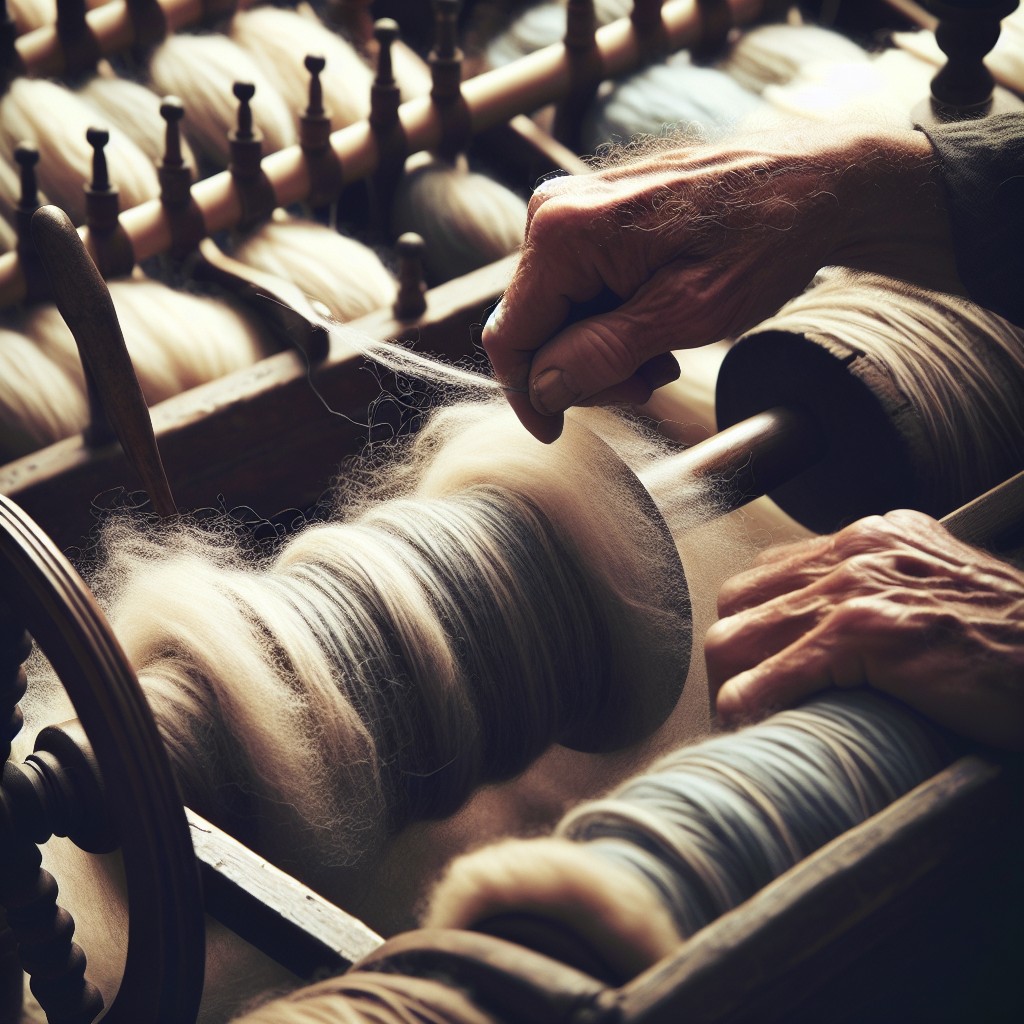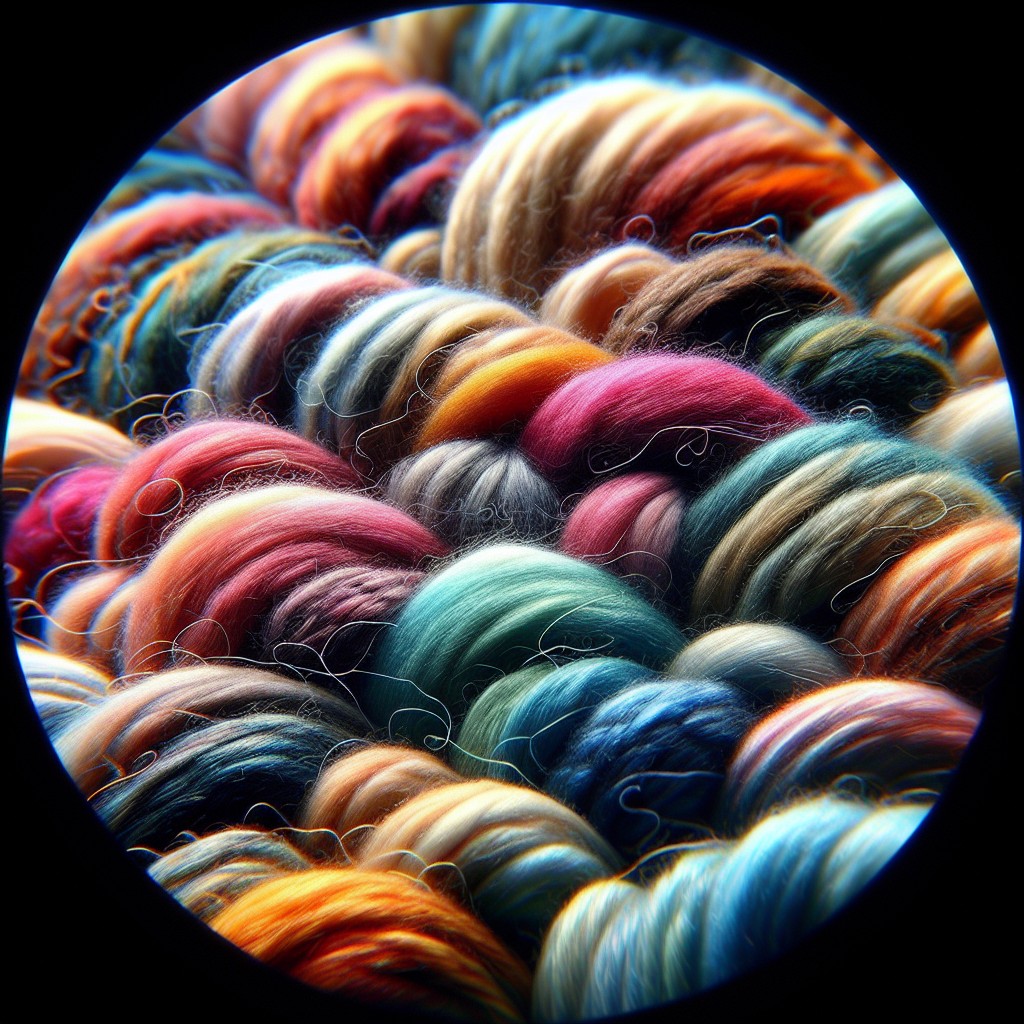Dive into the world of roving yarn, because its lush texture and unique properties make it a must-explore for every yarn enthusiast.
Roving yarn is a fascinating and versatile material in your knitting and crocheting toolbox. Gaining a deep understanding of what roving yarn is, its unique properties, ideal applications, and tips for working with this type of yarn can make your crafting experience even more delightful.
In this comprehensive article, you’re set to uncover the distinctiveness of roving yarn, its rich textures, and the beautiful, varied projects it can create. From basic facts to advanced insights like choice and handling, we’ll delve into every minute detail, equipping you with all the desired knowledge about roving yarn.
Let’s unravel this soft, unspun wool together!
Key takeaways:
- Roving yarn is unspun and has a unique fluffy texture.
- Types of roving yarn include wool, silk, alpaca, and cotton.
- Roving yarn is used for knitting, crochet, felting, rugs, and macrame.
- Roving yarn is soft, warm, and comes in vibrant colors.
- Challenges with roving yarn include breakage and felting.
Definition of Roving Yarn

Roving is a unique type of yarn, less processed than typical yarns. Its main distinguishing feature is its unspun, loose form, which gives it an interesting textural quality, often described as fluffy or woolly. Derived mostly from wool, it can also be made from other fibers, including cotton and silk.
As it’s unspun, roving is primarily composed of long, continuous fibers arranged in a parallel fashion, as opposed to the twisted fibers found in regular spun yarn. This arrangement endows roving with unique properties beneficial to specific crafting projects, offering an entirely different crafting experience.
Types of Roving Yarn

Roving yarn is typically categorized by its composition and its spin. Fibers such as wool, silk, alpaca, and cotton are common in roving yarn mixtures, each offering unique characteristics. Wool roving tends to be warm, soft, and durable, while silk roving is considered luxurious and lustrously shiny. Alpaca roving provides softness and thermal qualities, and cotton roving is appreciated for being lightweight and breathable.
Another important aspect of roving yarn types is the method of spinning. For instance, worsted roving has been combed to align the fibers, resulting in a yarn that’s smooth and less prone to pilling, while woolen roving yarns are carded, creating a more lofty and warm yarn.
Lastly, the processing method can create additional roving yarn types like superwash roving, a wool yarn that has been treated to resist felting, a feature that appeals to many knitters and crocheters. This way, each type of roving yarn serves a distinct purpose that entirely depends on the project at hand.
The Process of Creating Roving Yarn

The production of roving yarn begins with the sheep shearing process. The wool is then prepped by washing it to remove any dirt and greases. After this, the wool undergoes a process called carding which helps to align the fibers for spinning and remove any remaining impurities.
Next comes the formation of roving through a method known as drafting. This involves pulling and stretching the fibers to the desired thickness. It’s essential to perform this step gradually and patiently, as overzealous pulling can cause the roving to tear.
The final stage is spinning, where the roving is twisted to create yarn. The degree of twist can be adjusted to meet specific requirements and can greatly influence the yarn’s resulting strength and texture.
It’s important to remember that the process may vary slightly based on the type of fiber being used. For example, synthetic fibers require more specialized handling and processing machinery than natural wool. However, the core principles of washing, carding, drafting, and spinning remain consistent across different fiber types.
Characteristics of Roving Yarn

Roving yarn distinctively stands out due to its bulkiness, making it thicker than most yarn types. It’s often incredibly soft which is primarily due to the minimal processing it undergoes, preserving the fiber’s natural texture. This minimalistic intervention also retains an important characteristic of roving yarn – it is a single strand and not twisted. Resultantly, it may seem loosely spun or not spun at all, giving it a unique fluffiness.
Though providing a plush finish, roving yarn isn’t resilient or elastic like other yarn types, making it a delicate choice for certain projects. Additionally, the color of this yarn is generally vivid and intense, thanks to the dyeing process which occurs before spinning, enhancing the absorption of color. With an array of unique characteristics, it’s imperative to consider the project’s demands when opting for roving yarn.
Uses of Roving Yarn in Craft Projects
Roving yarn is highly versatile and adaptable to many craft scenarios. Predominantly, you’ll find it being used to create chunky and cozy knit blankets, lends itself particularly well due to its thickness and texture. Handspun scarves, hats, or sweaters are other excellent applications that not only feel warm and soft but also add a stylish, unique flair.
In addition to clothing and home decor, many crafters use roving yarn for felting projects. It is the perfect pick for needle felting due to its loose, unspun nature. This allows it to be easily molded into intricate shapes and patterns.
Rug making is another area where roving yarn shines, creating plush and comfortable pieces. Its sturdiness also makes it a go-to for macrame, delivering textures and patterns that are visually delightful and structurally durable.
Finally, don’t overlook its function as a beautiful weave in tapestry. The right piece can tie a whole room together, and using roving yarn can provide a tactile dimension that typical threads fail to match. This yarn’s unique properties open up endless possibilities for artistic expression in the hands of a creative crafter.
Benefits of Using Roving Yarn
Roving yarn brings several distinct advantages to knitting and crocheting projects.
Firstly, it’s known for its superior softness. This attribute makes it ideal for crafting pieces that call for comfort and warmth, such as sweaters, blankets, or scarves.
Secondly, roving yarn lends a unique rustic charm to finished products due to its thick and fuzzy texture. No two items are identical when crafted with roving, truly adding a unique touch to your works.
Additionally, roving is extremely warm. It traps air effectively, making items made with it particularly suitable for colder weather.
Lastly, its bulkiness allows for quicker knitting or crocheting. Large needles or hooks can be used, which means projects can be completed faster than using traditional yarns. This makes roving a great option for those who want speedy results without sacrificing quality or aesthetics.
Bear in mind these points when incorporating roving yarn into your next crafting adventure.
Differentiating Roving Yarn From Other Types of Yarn
Roving yarn proves distinct from its counterparts in several key aspects. It’s less processed than other types, composed of long, thick fibers that are twisted together rather than spun, a detail that gives it a unique texture.
Its structure, a continuous strand with fiber alignment in one direction, offers a dramatically different crafting experience.
Compared to traditional plied yarn, which features several threads twisted together, roving permits bulkier knit or crochet results due to its thickness, creating plush and cozy crafts. However, this attribute also demands different gauge considerations when you seek specific project dimensions.
Unlike most yarn types, the concise processing of roving leaves it predisposed to felting. Thus, it’s an ideal choice for projects requiring the dimensional stability offered by felted textures. This felting propensity, though, entails careful washing instructions to avoid unintended felting or shrinking.
Lastly, roving is the prime pick for spinning your own yarn, a craft reserved for only the hardiest yarn enthusiasts. Until you endeavor into spinning, don’t fret the term ‘unspun’ often associated with roving. Its crafting promise goes far beyond spinning alone!
Choosing the Right Roving Yarn for Your Project
It’s essential to match the type of roving yarn to the demands of your project. Gauge, or stitches per inch, is a key factor. Heavier yarns, such as chunky or bulky roving, are ideal for larger projects like throws or rugs, due to their ability to quickly cover a large area.
Lighter weight roving, on the other hand, is a great choice for more delicate items such as scarves or hats. Remember, finer yarns create more detailed stitch definition but will take longer to work with.
Fiber content is another important consideration. Wool is a classic choice for both warmth and durability, while silk roving yarn offers a luxurious sheen and drape. Do you love vibrant colors? Consider a roving blend that includes a touch of bright acrylic.
Lastly, your roving’s texture can significantly impact the end product. Smooth roving is easy to work with and creates a polished, uniform look, while beautifully uneven varieties lend a rustic, handmade feel to the finish.
Through careful selection of the right roving yarn, you can ensure your masterpiece is both visually stunning and highly functional.
Challenges With Roving Yarn and Tips to Overcome Them
While roving yarn provides a unique aesthetic and texture to your projects, it can be a bit tricky to work with, especially for beginners. Its unspun structure makes it more susceptible to breakage compared to spun yarns. Don’t be disheartened if the yarn snaps during your crafting sessions – it’s a common issue but easy enough to resolve. Simply overlap the two broken ends and twist them together gently, and you can continue stitching.
Another challenge might be related to felting. Roving yarn, especially wool, tends to felt with friction. While this can be a plus for some projects where felting is useful, for others, you would want to avoid it. To help prevent felting, be careful not to overwork the yarn and handle it delicately.
Moreover, roving yarn can be a bit slippery and challenging to control on the needles for some. It may help to use wooden or bamboo needles which have a bit of grip, compared to metal ones.
Remember, practice makes perfect. The more you interact with roving yarn, the more accustomed you will become to its nuances, and over time, you’ll be able to manage these minor obstacles with ease. Understanding the nature of roving yarn and how to counter its challenges will eventually allow you to fully exploit its unique appeal and potential in your crafts.
Merino Wool As a Popular Roving Yarn Choice
Boasting a soft touch and warm coziness, Merino wool often tops the list of preferred roving yarn options. This type of wool comes from the Merino sheep, praised for its ultra-fine and long fibers. These qualities contribute to a less scratchy and more comfortable finish, perfect for wearable crafts.
Merino wool roving yarn is also a flexible choice, easily spun into different levels of thickness, from thin lace-like yarns to bulkier options for impactful texture. Its long fibers make it durable, suitable for projects that require resilience, be it an intricately knitted sweater or a simple, cozy afghan.
Rich in color absorption, another attractive point is its versatility in hues. Whether dyed or natural, each strand catches the light distinctly, lending depth and vibrancy to finalized craftworks whether they are felted animals, wall hangings or scarves. No wonder many crafters reach for Merino wool when roving yarn is needed.
Perhaps, the only downside could be the cost as Merino wool tends to be pricier due to its high quality. However, the outstanding features and gorgeous finish it provides are often worth the investment. Handling it requires care – regular hand wash is recommendable, and drying it flat helps to preserve the shape and texture of your craft.
Diverse Colors of Merino Wool Roving Yarn
Merino wool roving yarn is an absolute treat for fiber artists due to its vibrant and diverse color palette. Starting from the earthly tones of browns and greens, moving to the vivid brights of pinks and yellows, there is a shade for every project. Not only does this preference offer creative flexibility, but it also means your finished pieces can easily integrate into a variety of décor styles.
This variability is achieved through different dying techniques. With solid dying, the process ensures that the whole roving yarn gets imbued with a single, rich hue. However, when it comes to multicolored or variegated roving, the process involves carefully applied colors in particular sections, creating a stunning blend of shades in the final product. The unique character of these color transitions adds a whimsical touch to any crafted piece.
Bear in mind that although the colors are steadfast due to the treating process, they may vary slightly from batch to batch. This aspect lends to the unique charm of each roving bundle, making every crafted piece a one-of-a-kind work of art.
Finally, for those seeking a natural and organic aesthetic, undyed versions uphold the raw beauty of the wool, boasting a range of natural sheep colors from soft white to light grey and deep charcoal. For added sustainability, eco-friendly dyes can be used to color these as per individual taste and preference.
Product Details of Quality Roving Yarn
To ensure a great crafting experience, quality roving yarn should possess several attributes. First, top-grade roving yarn exhibits exceptional softness – it should feel like a cloud in your hands, making it a joy to work with.
Next, the thickness is an essential factor. Roving yarn is typically bulkier than other yarn types, providing a satisfying heft to your projects.
Color vibrancy is another marker of quality. The yarn should display deep and intense hues which do not easily fade over time or after repeated washing.
Resilience is crucial, too; a quality roving yarn must maintain its integrity without easily splitting or fraying, ensuring your projects last long.
Finally, quality roving yarn should offer a healthy elasticity, allowing it to stretch and bounce back to its original shape – a critical factor when knitting or crocheting wearable items.
Now that you know what to look for, you can better assess the quality of roving yarn for your next project. Happy crafting!
Reviews & Ratings of Roving Yarn
When assessing reviews and ratings of roving yarn, it’s beneficial to take certain factors into account. On quality parameters, good roving yarn should have a luxuriant feel and the fiber should hold together well without separating too easily.
Product consistency is another crucial factor. Repeated purchases should yield the same quality, hue, and texture. Hence, ratings on consistency can be highly informative.
Look for reviews that discuss the color accuracy of the yarn to the images provided by the vendor. This ensures that you’ll get the hues you’ve selected for your project.
Lastly, shipping and packaging reviews can indicate whether the vendor takes care of the product during transit and it reaches the buyer in excellent condition.
Always look for products with numerous reviews as this indicates popularity and adds legitimacy to the ratings. Products with a rating of 4 or above on a 5-point scale usually assure of quality and satisfaction.
FAQ
What is a roving yarn?
Roving yarn is a type of yarn made from long, narrow bundles of fiber, typically used in spinning, knitting, and other textile arts.
What is the roving process of yarn?
The roving process of yarn refers to a preliminary step used exclusively for ring spinning, where finisher-drawn carded or combed slivers undergo a simple roller drafting method to decrease the linear weight, thus, achieving an optimum size for the yarn count to be spun.
What is the difference between worsted and roving wool?
Worsted wool is created by combing fibers to align them parallelly, while roving wool is a woolen prep where fibers are arranged randomly with lots of air added.
How does the texture and feel of roving yarn influence the final crafted item?
The texture and feel of roving yarn significantly affect the final crafted item, making it softer, bulkier, and more luxurious due to its loosely-twisted, unspun configuration.
What are some common projects suitable for roving yarn?
Roving yarn is often used for projects like chunky blankets, scarves, hats, and other large, cozy items due to its thick, lofty texture.
What are the tips for maintaining and caring for items made with roving yarn?
To maintain and care for items made with roving yarn, avoid high temperatures and friction during washing, air dry flat, and store carefully to prevent damage.
